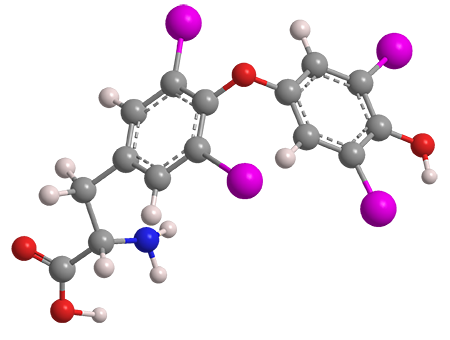What molecule am I?


L-Thyroxine is an amino acid that is one of two hormones located in the thyroid gland; the other is triiodothyronine1. Under the name levothyroxine, it is also a manufactured drug used to treat hypothyroidism. The molecule’s enantiomer, D-thyroxine, has no pharmacological activity.
In 1915, chemist Edward. C. Kendall at the Mayo Foundation (Rochester, MN) isolated thyroxine from unspecified animals. In the following decade, Kendall wrote several more articles on the biochemistry and pharmacology of thyroxine, including the influence of the thyroid gland on oxidation in the animal organism. Kendall received the Nobel Prize for Physiology or Medicine in 1950 for his research on adrenal gland hormones, not thyroid hormones.
In 1926, Charles R. Harington at University College London elucidated the structure of thyroxine. The next year, he and George Barger synthesized it in several steps beginning with p-hydroxyanisole and 3,4,5-triidonitrobenzene; later in the synthesis, they introduced the tyrosine moiety.
To this day, thyroxine, familiarly known by the trade name Synthroid (Abbvie, North Chicago, IL), is the second most prescribed drug in the United States. The active ingredient is the sodium salt, not the free acid.
1. CAS Reg. No. 6893-02-3.
L-Thyroxine hazard information*
| Hazard class** | GHS code and hazard statement | |
|---|---|---|
| Acute toxicity, oral, category 4 | H302—Harmful if swallowed | |
| Skin corrosion/irritation, category 2 | H315—Causes skin irritation | |
| Serious eye damage/eye irritation, category 2A | H319—Causes serious eye irritation | |
| Specific target organ toxicity, single exposure, respiratory tract irritation, category 3 | H335—May cause respiratory irritation | |
*Compilation of multiple safety data sheets.
**Globally Harmonized System (GHS) of Classification and Labeling of Chemicals. Explanation of pictograms.
Molecules from the journals
1,3,3-Trinitroazetidine1 (TNAZ) is a strained molecule with a high density of nitrogen atoms. This combination gives it considerable potential energy, with a heat of decomposition of >6 J/g.
TNAZ was synthesized in 1989 by T. G. Archibald and coauthors at Fluorochem (Azusa, CA) and the US Naval Research Laboratory (Washington, DC). Because of its low melting point and high thermal stability as a liquid, it was proposed as a replacement for TNT2, but its high vapor pressure eliminated it as a melt-castable TNT substitute.
This past October, Jesse J. Sabatini, Corinna S. Schindler, and collaborators at the DEVCOM Army Research Laboratory (Aberdeen Proving Ground, MD) and the University of Michigan (Ann Arbor) described photochemical strategies for synthesizing tunable derivatives of TNAZ and other azetidines for use as melt-castable energetic compounds and propellant plasticizers.
Sesamol3 is a natural benzodioxole derivative found in sesame seeds and oil. In 1928, Dutch chemist W. Adriani distinguished it from two other sesame constituents, sesamolin4 and sesamin5, both of which contain two benzodioxole units.
Sesamol has been used as an antioxidant for diverse substances such as soybean oil, methyl linoleate, and phosphatidylcholine hydroperoxide. Recently, Tian Yuan and colleagues at Northwest A&F University (Yangling) and BGI Institute of Applied Agriculture (Shenzhen, both in China) reported a potentially valuable medical use of the compound.
Yuan et al. discovered that sesamol attenuates scopolamine-induced cholinergic disorders, neuroinflammation, and cognitive deficits in mice. Their finding that sesamol supplementation alleviates cognitive dysfunction could lead to new treatments for Alzheimer’s disease.
1. CAS Reg. No. 97645-24-4.
2. CAS Reg. No. 118-96-7.
3. CAS Reg. No. 533-31-3.
4. CAS Reg. No. 526-07-8.
5. CAS Reg. No. 607-80-7.
Molecules from the Journals
MOTW briefly describes noteworthy molecules that appeared in recent ACS journal articles. See this week's
edition below.
This molecule was suggested by a reader. We present almost all of the molecules suggested by our readers. If you have a molecule you would like us to consider, please send us a message. And thank you for your interest in Molecule of the Week! —Ed.
L-Thyroxine Fast Facts
| CAS Reg. No. | 51-48-9 |
| SciFinder nomenclature | L-Tyrosine, O-(4-hydroxy-3,5-diiodophenyl)-3,5-diiodo- |
| Empirical formula | C15H11I4NO4 |
| Molar mass | 776.87 g/mol |
| Appearance | White to cream-colored crystals or powder |
| Melting point | 235–236 °C (dec.) |
| Water solubility | ≈0.2 mg/L (est.) |

Learn more about this molecule from CAS, the most authoritative and comprehensive source for chemical information.
Molecule of the Week needs your suggestions!
If your favorite molecule is not in our archive, please send us a message. The molecule can be notable for its current or historical importance or for any quirky reason. Thank you!
Stay Ahead of the Chemistry Curve
Learn how ACS can help you stay ahead in the world of chemistry.

